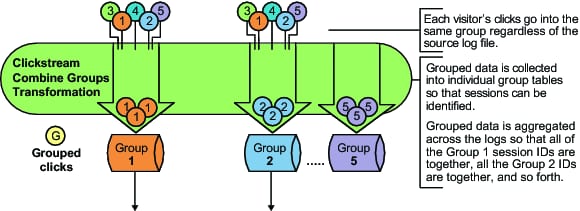Stages in Template Jobs
Overview
Note: This topic
describes the stages in the standard Web log basic template job. The
page-tagging version of the template contains the Parse Tagged Data
Items transformation in the Loop One: Recognize, Parse, Group Data
stage of the job. This transformation is a renamed Clickstream Parse
transformation.
Prepare Data and Parameter Values to Pass to Loop 1
The Read
Me First note in the job flow contains information that is necessary
for the initial setup and modification of this job. You might need
to edit the following values in the Parameters tab for the job:
supplies the e-mail
address in the Checkpoint transformations in the template. This address
is used for failure notification.
determines the number
of folders that are created for holding output for the parallel executions
of the Clickstream Parse transformation in the first loop. Set this
value to match the default value that was used in the setup job. If
that value was changed in the setup job, then it should also be updated
here.
determines how many
groups of data are created by the Clickstream Parse transformation
during the first loop. Therefore, it also determines the maximum
number of parallel executions for Clickstream Sessionize during the
second loop. Set this parameter value to match the default value that
was used in the setup job. If that value was changed in the setup
job, then it should also be updated here.
Locate and Parse Transformations and Tables
Loop One: Recognize, Decode, Parse, and Group Data
The
second stage contains the first loop job. The transformations in the
first loop job represent the subjob, which is the job that is run
in parallel. For a standard Web log, each stream consists of a Clickstream
Log transformation, a Clickstream Parse transformation, and two checkpoints,
which are created by renaming the Return Code transformation and which
enable you to configure how errors are processed.
Loop One Transformations
When you
process SAS page tag logs, an additional Clickstream Parse transformation
(and associated RC Check) are inserted in order to process the data
elements collected by the SAS page tag (after the RC Check-Log transformation
and before the Clickstream Parse transformation). This additional
Clickstream Parse transformation is named Parse Tagged Data Items.
For a partial list of the data elements processed by this additional
transformation, see SAS Page Tag Predefined Data Elements Reference.
Combine Groups
Loop Two: Sessionize
The fourth stage consists of
the second loop. This stage contains transformations and tables that
run the loop and sessionize the data.
Sessionize Transformations
|
Sets the parameters
that are passed through to the subjobs. The following parameters are
set:
|
||
|
A parameterized table
for receiving the output from the Clickstream Parse transformation
and passing it into the Clickstream Sessionize transformation. (See Propagating Columns in Jobs that use the Loop Transformation if you have
defined User Columns that need to be propagated to the final detail
table.)
|
||
|
Stores CLICKSTREAM_SESSIONIZE
output and ensures the sort sequence of the output data is correct.
(See Backing Up PERMLIB.)
|
||







